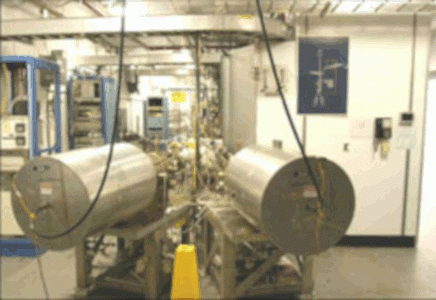Injector Advance: The Superlattice Photocathode

The two electron guns at the start of the CEBAF injector rely on newly developed superlattice photocathodes.
Additional Links
Improved technology for originating CEBAF's electron beam enables nuclear physics experimenters to gather better data more efficiently. CEBAF's injector originates the electron beam, establishes its special characteristics, and then injects it into the accelerator. Over time, as CEBAF experiments generate new knowledge, nuclear physics researchers need to interrogate nature itself ever more deeply — which means they need increasingly exacting characteristics in the beam. That makes injector advances important. JLab has advanced injector technology in lots of ways, but one research-and-development achievement meriting particular attention is the superlattice photocathode.
An injector's photocathode is the ultimate source of the beam's electrons. The CEBAF beam originates in either of a pair of electron guns, each driven by laser light. The gun uses photons — particles of light — to strip electrons from a photocathode. A few years ago, CEBAF's photocathodes were dime-sized crystals of a material called bulk gallium arsenide, but superlattice photocathodes use thin layers of gallium arsenide grown atop layers of gallium arsenide phosphide to alter the energy states of the material and provide much higher electron beam polarization.
Polarization can be thought of as precisely orienting the electrons' spin. This beam characteristic is crucial for more and more CEBAF experiments because it lets experimenters draw ever more precise inferences from their data. The new kind of photocathode allows for very high polarization — and the higher the polarization, the more efficient the data collection. That, in turn, makes CEBAF itself more efficient, because it lets a given experiment use less of the beam time that is in such great demand.
For some time before 2005, experimenters could expect beam polarization at the level of 75%. During 2005, CEBAF crossed the 80% threshold and reached beyond 85%. The recent Hall A Proton Parity Experiments, HAPPEx and HAPPExII, required high polarization, and profited greatly from the superlattice photocathode.
Reference
M. Baylac et al. Physical Review Special Topics – Accelerators and Beams 8, 123501 (2005)

